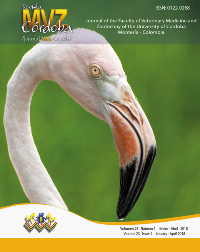Ethological annotations of Milvago chimachima, Vieillot, 1816 (Aves: Falconidae)
Anotaciones etológicas de Milvago chimachima, Vieillot, 1816 (Aves: Falconidae)
How to Cite
De La Ossa V, J., De La Ossa-Lacayo, A., & Montes V, D. (2018). Ethological annotations of Milvago chimachima, Vieillot, 1816 (Aves: Falconidae). Journal MVZ Cordoba, 23(1), 6514-6522. https://doi.org/10.21897/rmvz.1246
Dimensions
Show authors biography
Article visits 2162 | PDF visits
Downloads
Download data is not yet available.
- Del Hoyo J, Elliott A, Sargatal J. (Eds). Handbook of the Birds of the World. Vol. 2. New World Vultures to Guineafowl, Lynx editions; Barcelona; 1994.
- Rodríguez Mata J, Erize F, Rumboll, M. Aves de Sudamérica: Guía de campo Collins. No Paseriformes. Letemendía Casa Editora; Buenos Aires: 2006.
- Hilty S, Brown W. A guide to the Birds of Colombia. Princeton University Press; New Jersey. USA: 1986.
- Márquez C, Bechard M, Gast F, Vanegas VH. Aves rapaces diurnas de Colombia. Instituto de Investigación de Recursos Biológicos Alexander von Humboldt; 2005.
- Blake ER. Manual of Neotropical Birds. The University of Chicago Press; Chicago: 1977.
- Sazima I. Unexpected cleaners: Black Vultures (Coragyps atratus) remove debris, ticks, and peck at sores of capybaras (Hydrochoerus hydrochaeris), with an overview of tick-removing birds in Brazil. Revista Brasileira de Ornitologia 2007; 15(3):417-426.
- De La Ossa VJ, De La Ossa-Lacayo A. Aspectos de la densidad poblacional e historia natural de Milvago chimachima (AVES: Falconidae) en el área urbana de Sincelejo (Sucre, Colombia). Universitas Scientiarum 2011; 16(1):63-69. https://doi.org/10.11144/javeriana.SC16-1.aotp
- Holdridge LR. Ecología basada en zonas de vida. Instituto Interamericano de Ciencias Agrícolas; San José. Costa Rica: 1979.
- Farnsworth GL, Pollock KH, Nichols JD, Simons TR, Hines JE, Sauer, JR. A removal model for estimating detection probabilities from point-count surveys. The Auk 2002; 119:414-425.
- https://doi.org/10.2307/4089888 https://doi.org/10.1642/0004-8038(2002)119[0414:ARMFED]2.0.CO;2
- Johansson CA, Linder ET, White CM, Lyra Fleury JC. Nesting observations of the yellow-headed caracara in the Cerrado region of Brazil. Ornitologia Neotropical 1999; 10:211–215.
- Monteiro-Filho E. Fishing behavior of Yellow-headed Caracara, Milvago chimachima (Falconidae) in southeast Brazil. Ciencia e Cultura 1995; 47(1-2):86-87.
- White CM, Olson PD, Kiff LF. Family Falconidae (falcons and caracaras). In Handbook of the birds of the world, Vol. 2: New World vultures to tapaculos. Del Hoyo AE, Sargatal J. (eds), Lynx Edicions: Barcelona 1994.
- Sazima I, Olmos F. The Chimango Caracara (Milvago chimango), an additional fisher among Caracarini falcons. Biota Neotrop 2009; 9(3):403-405. https://doi.org/10.1590/S1676-06032009000300036
- Olmos F, Sazima I. Fishing behaviour by Black Caracaras (Daptrius ater) in the Amazon. Biota Neotrop 2009; 9(3):399-401. https://doi.org/10.1590/S1676-06032009000300035
- Bierregaard RO Jr. Conservation status of birds of prey in the South American tropics. J. Raptor Res 1998; 32:19–27.
- Vargas-Masís R, Bustamante-Ho A, Bellanero-MD. Transmisión de patrones de comportamiento entre individuos de Caracara Cabecigualdo (Milvago chimachima) en la zona sur, Costa Rica. Zeledonia 2014; 18(2):62-66.
- Healya SD; Hurly TA. Spatial Learning and Memory in Birds. Brain Behav. Evol 2004; 63:211–220. https://doi.org/10.1159/000076782
- Brenowitz EA, Beecher MD. Song learning in birds: diversity and plasticity, opportunities and challenges. Trends in Neurosciences 2005; 28(3):127-132.
- https://doi.org/10.1016/j.tins.2005.01.004
- Catchpole CK, Slater PJB. (Eds.). Bird song: Biological themes and variations. Cam-bridge University Press, Cambridge: United Kingdom; 1995.
- Aldana-Domínguez J, Gómez de la Rosa C, Borja Acu-a R. Patrimonio emplumado de la Universidad del Norte. Guía de campo. Universidad del Norte: Barraquilla, Colombia; 2015.
- Curio E. The adaptive significance of avian mobbing.I. Teleonomic hypothesis and predictions. Zeitschrift fur Tierpsychologie 1978; 48:175-183
- Dominey WJ. Mobbing in colonially nesting fish, especially the bluegill, Lepomis macrochirus. Copeia 1983; 4:1086-1088. https://doi.org/10.2307/1445113
- Arnold KE. Group mobbing behaviour and nest defence in a cooperatively breeding Australian bird. Ethology 2000; 106:385–393. https://doi.org/10.1046/j.1439-0310.2000.00545.x
- Osthreiher R. Is mobbing altruistic or selfish behaviour?. Animal Behaviour 2003; 66:145-149. https://doi.org/10.1006/anbe.2003.2165
























